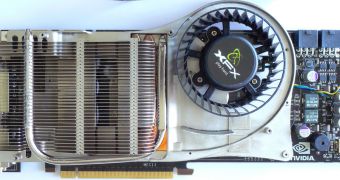Every time a new type of video card comes out, it produces a worldwide quake. Although this statement may seem a little too much at first, if you look at the launch of the 7 and 8 Geforce series you will notice that performance has almost doubled from one generation to another. And that comes in handy especially if you want to play the latest games since these ones can be very hardware intensive.
After the arrival of the 8800 GTX series, everyone waited for Nvidia to roll out a card capable of surpassing Ati/AMD's R600 on every level. The 8800 Ultra was supposed to have GDDR4 chips and a very fast GPU. However when it did come out, the Ultra only came as a tweaked version of the GTX clocked some 10-15% higher on both GPU and GDDR3 chips. Fortunately, not every Nvidia integrator uses the reference model and because of that it was possible for XFX to build what is at the moment the fastest consumer-end card of the moment.
Dubbed "Geforce 8800 Ultra Extreme", this particular model has the following box code: PV-T80U-SHD9. Excepting for the code, this card looks just like any other Ultra starting with the huge heatsink and ending with the specific XFX color scheme. However unlike a classic Ultra, the latest XFX comes clocked at 675MHz for the GPU and 1667MHz for the shader units. The GDDR3 chips also come clocked at an impressive 2300MHz-DDR(1150 effective).
The G80 A3 chip comes packed with the same set as the older A2 revision but unlike the older one, the new A3 is more power efficient. The same can be said about the Samsung GDDR3 chips too which are pretty unique. The K4J52324QE-BJ08 series uses 0.8ns chips and that can come in handy since they can work at higher clockspeeds than the classical 1ns used on the standard 8800.
At 108.8GB/s the card is indeed a monster producing some impressive results in most games. The scores are some 5-8% higher than those registered on a regular Ultra and that can come in handy if you use very high resolutions and HDR/AA settings. And if you have a very fast system you can even produce an 11000+ score in 3Dmark 2006 with no further overclock. The only problem is its price since currently a single card will set you back at least $900 or more, depending on your retailer.
We are just a few, but there are many of you, Softpedia users, out there. That's why we thought it would be a good idea to create an email address for you to help us a little in finding gadgets we missed. Interesting links are bound to be posted with recognition going mainly to those who submit. The address is  .
.

 14 DAY TRIAL //
14 DAY TRIAL //